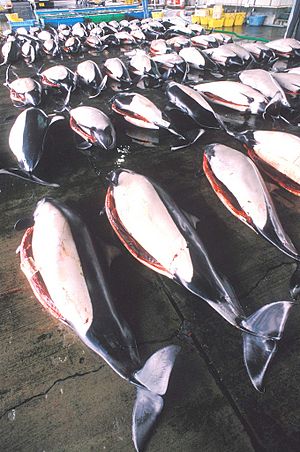Dall's porpoise facts for kids
Quick facts for kids Dall's porpoise |
|
|---|---|
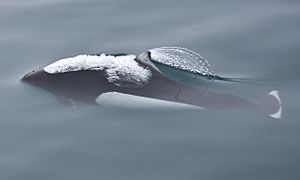 |
|
 |
|
| Size compared to an average human | |
| Conservation status | |
| Scientific classification | |
| Genus: |
Phocoenoides
|
| Species: |
dalli
|
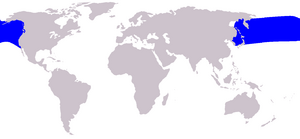 |
|
| Dall's porpoise range | |
The Dall's porpoise (Phocoenoides dalli) is a fast-swimming porpoise found only in the North Pacific Ocean. It is the biggest type of porpoise and the only member of its group, called Phocoenoides. This amazing sea animal is named after an American scientist named W. H. Dall.
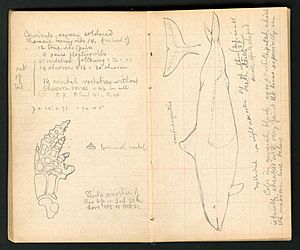
Contents
What is a Dall's Porpoise?
Dall's porpoises are easy to spot because they look different from other porpoises. They have a strong, wide body and a small head without a clear beak. Their flippers are near the front of their body. They also have a triangular fin on their back, called a dorsal fin.
How Big Are They?
Dall's porpoises are the largest porpoise species. They can grow up to 7.5 feet (2.3 meters) long. They usually weigh between 370 and 490 pounds (130 and 220 kg). Male porpoises are generally bigger than females. They also have a different shape to their tail area.
What Colors Are They?
Most Dall's porpoises are black. They have white or grey patches on their sides and belly. Their dorsal fin and the back edge of their tail (fluke) often look "frosted" with white. Baby Dall's porpoises are usually grey and don't have the frosted look yet.
There are two main color types: the dalli-type and the truei-type. The truei-type is found only in the western Pacific. It has a white belly patch that reaches further forward on its body.
Where Do They Live?
Dall's porpoises live only in the cold waters of the North Pacific Ocean. You can find them from California all the way to the Bering Sea and the Sea of Okhotsk. In the west, they live down to the Sea of Japan. They usually like water that is colder than 64°F (18°C).
They mostly live far from shore in deeper ocean waters. However, they can also be found closer to the coast. This happens near deep underwater valleys or in long, narrow sea inlets called fjords.
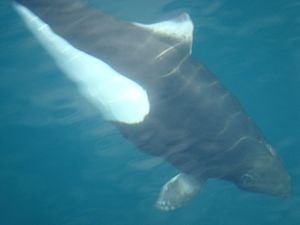
How Do They Behave?
Dall's porpoises are very active swimmers. They are known for creating a special spray of water called a "rooster tail" when they swim fast at the surface. They often swim near boats to "bowride," which means they surf on the waves made by the boat's front. They also ride waves made by larger whales.
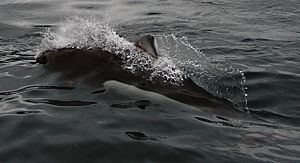
What Do They Eat?
Dall's porpoises are not picky eaters. They hunt many different kinds of fish and squid that live near the surface or in the middle of the ocean. They mostly eat fish like lanternfish and a type of squid called gonatid squid. Sometimes, they might eat small crustaceans like krill or shrimp, but this is not their main food. They usually stay close to the surface to find food, but they can dive deep, sometimes up to 94 meters!
How Do They Live Together?
Dall's porpoises usually live in small groups of 2 to 10 individuals. But sometimes, hundreds of them can gather together! Males compete to mate with females. During mating season, a male might stay close to a female to make sure he is the father of her babies.
Babies are usually born in the summer after about 11 to 12 months of pregnancy. Females typically have a baby every three years. Dall's porpoises usually live for about 15 to 20 years.
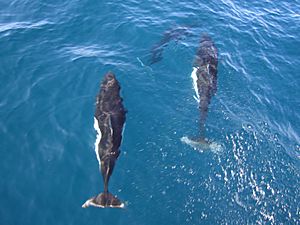
Who Are Their Friends and Enemies?
Killer whales sometimes hunt Dall's porpoises. However, Dall's porpoises have also been seen swimming with certain groups of killer whales. They even seem to play with the killer whale babies! One Dall's porpoise was seen traveling with a group of killer whales for several months in 1984.
How Many Dall's Porpoises Are There?
Scientists believe there are over 1 million Dall's porpoises in the world. However, it's hard to know if their numbers are going up or down right now.
- Along the coasts of California, Oregon, and Washington, there are about 25,800 porpoises.
- Alaska has about 83,400 porpoises.
- Coastal British Columbia has nearly 5,000 individuals.
In the western North Pacific, the numbers are divided by their color types and how they move.
- About 162,000 dalli-type porpoises live offshore.
- Around 173,000 dalli-type porpoises travel between Japan and the southern Okhotsk Sea.
- About 111,000 dalli-type porpoises migrate to the Okhotsk Sea in the summer.
- Roughly 178,000 truei-type porpoises migrate between Japan and the central Okhotsk Sea.
What Threats Do They Face?
Dall's porpoises face several challenges that can affect their populations.
Accidental Catch in Fishing Nets
One big threat is getting accidentally caught in fishing nets, which is called fisheries bycatch. In the past, thousands of Dall's porpoises were caught in large commercial driftnet fisheries. The United Nations stopped these nets in the 1990s. Before that, about 8,000 Dall's porpoises were caught in just one year (1989-1990). Even today, some fishing nets still operate in certain areas, leading to porpoises being caught by accident.
Hunting for Meat
Dall's porpoises are still hunted for their meat in Japan. The number of porpoises hunted increased after the 1980s when hunting of larger whales was reduced. In 1988, over 45,000 Dall's porpoises were hunted. After other countries raised concerns, the Japanese government set limits. Today, a certain number of porpoises are allowed to be hunted each year. This is the largest direct hunt of any whale or porpoise species in the world. Scientists are concerned that these hunts might be too large for the porpoise populations to recover.
Pollution in the Ocean
Pollution is another problem for Dall's porpoises. Harmful chemicals like DDE and PCBs can build up in their bodies. These pollutants can cause health problems, affect their ability to have babies, and even lead to the death of young calves.
How Are They Protected?
The Dall's porpoise is listed as "Least Concern" on the IUCN Red List. This means they are not currently in danger of disappearing across their entire range. However, the actual numbers of porpoises caught by accident or hunted might be higher than reported. There is no clear sign that the species is declining everywhere.
The Dall's porpoise is also protected by international agreements. It is listed on Appendix II of the Convention on the Conservation of Migratory Species of Wild Animals (CMS). In the United States, like all other marine mammals, it is protected under the Marine Mammal Protection Act (MMPA).
See also
 In Spanish: Marsopa de Dall para niños
In Spanish: Marsopa de Dall para niños



